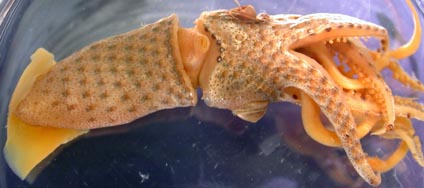Histioteuthis sp. A
Richard E. Young and Michael VecchioneIntroduction
This is a rather cyclindrical, muscular histioteuthid that is known only from five squid captured in the waters around the Hawaiian Islands.Diagnosis
A Histioteuthis ...- with a single sawtooth in Basal Row of photophores.
- with virtually symmetrical outer sucker rings in ventromarginal series on club manus.
Characteristics
- Tentacles
- Central suckers just slightly enlarged over marginal suckers.
- Suckers of ventral-marginal rows of manus with broad, but nearly symmetrical outer rings.
Figure. Left - Oral view of a swath across the manus of the club of Histioteuthis sp. A, 41 mm ML, Hawaii. The small suckers on the right are carpal suckers. Right - Oral view of a ventral-marginal sucker of the club, 41 mm ML, Hawaii. Photographs by R. Young.
- Medial manal suckers of club with slender teeth only on distal margin of inner ring; proximal margin with small teeth difficult to see under dissecting microscope.
Figure. Oral view of large, central manus suckers of the club of Histioteuthis sp. A, 41 mm ML,Hawaii.Photograph by R. Young.
Scanning electron micrographs of the arms and club suckers can be seen here.
- Photophores
- The Basal Row is comprised of 9 photophores, and forms a distinct sawtooth at left end.
Figure.Ventral view of posterior edge of head of Histioteuthis sp. A showing the Basal Row, 41 mm ML, Hawaii. Photograph by R. Young.
- The Basal Row is comprised of 9 photophores, and forms a distinct sawtooth at left end.
Comments
More details of the description can be found here.Species of the celetaria-group are characterized by:
- Head and arm photophores:
- Type 1b pattern on head.
- Basal Row of head with 9 or 10 photophores.
- Right Basal Series of head absent.
- Arms IV with 3 longitudinal series on arm base (drawing below).
 image info
image info Figure. Ventral view of arm IV, H. celetaria, 39 mm ML. Drawing from Voss, 1969 (Fig. 15f).
- Most species with separate group of 4-8 compound photophores on ends of arms IV (drawing above) (Voss, et al., 1998). Apparently this feature is absent in H. inermis.
- Compound photophores of large, uniform size and evenly spaced on anterior 2/3 of ventral mantle.
- Tubercles
- Absent.
The species differ in the following manner:
| Character | H. celetaria | H. inermis | H. pacifica | H. sp. A |
| Club suckers | ||||
| Asymmetrical outer sucker rings in: | 3 ventral-marginal sucker series | No asymmetrical rings | 2 ventral-marginal sucker series | No asymmetrical rings |
| Size of medial manal suckers: | Slightly larger than marginal suckers | 2 X marginal suckers | 1.5 X marginal suckers | Slightly larger than marginal suckers |
| Large manal-sucker dentition: | 12-13 teeth on distal margin | 20-27 teeth on entire margin | 28-32 teeth on entire margin | 15-20 teeth on distal margin |
| Photophores | ||||
| Single sawtooth in Basal Row photophore pattern: | Yes | No sawtooth | No sawtooth | Yes |
| Number of photophores in Basal Row: | 9 | 10 | 9 | 9 |
With the exception of the analysis of head photophores and the inclusion of H. inermis in this species group, most of the information presented in this table is from Voss (1969) and Voss, et al . (1998)
References
Voss, N. A. 1969. A monograph of the Cephalopoda of the North Atlantic: The family Histioteuthidae. Bull. Mar. Sci., 19: 713-867.
Voss, N.A., K. N. Nesis, P. G. Rodhouse. 1998. The cephalopod family Histioteuthidae (Oegopsida): Systematics, biology, and biogeography. Smithson. Contr. Zool., 586(2): 293-372.
Title Illustrations
| Scientific Name | Histioteuthis sp. A |
|---|---|
| Comments | Ventral view, 25 mm ML, Hawaiian waters, preserved. Photograph. |
| Copyright | © 2003 Richard E. Young |
About This Page
Drawing from Voss (1969) printed with the Permission of the Bulletin of Marine Science.
Richard E. Young
Dept of Oceanography
University of Hawaii
Honolulu, Hawaii 96822
USA
National Marine Fisheries Service
Systematics Laboratory
National Museum of Natural History
Washington, D. C. 20560
USA
Page copyright © 2003 Richard E. Young and
Citing this page:
Young, Richard E. and Vecchione, Michael. 2003. Histioteuthis sp. A . Version 01 January 2003 (under construction). http://tolweb.org/Histioteuthis_sp._A/19797/2003.01.01 in The Tree of Life Web Project, http://tolweb.org/












